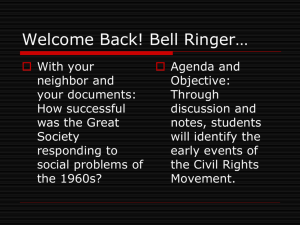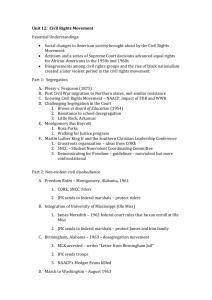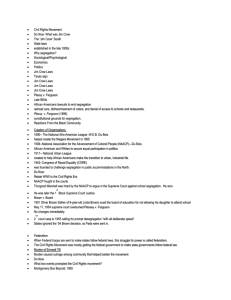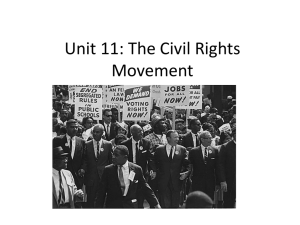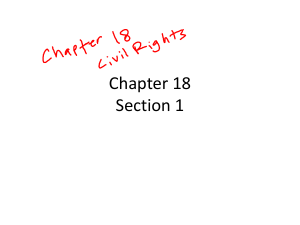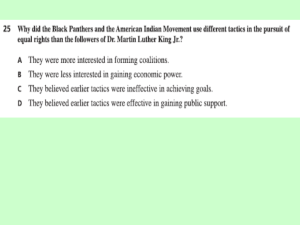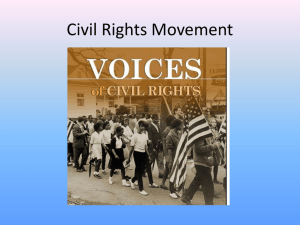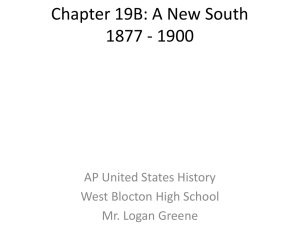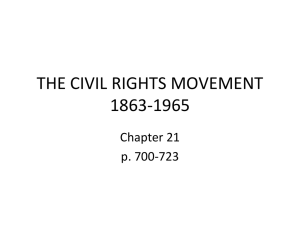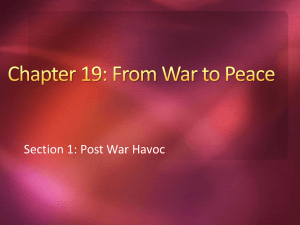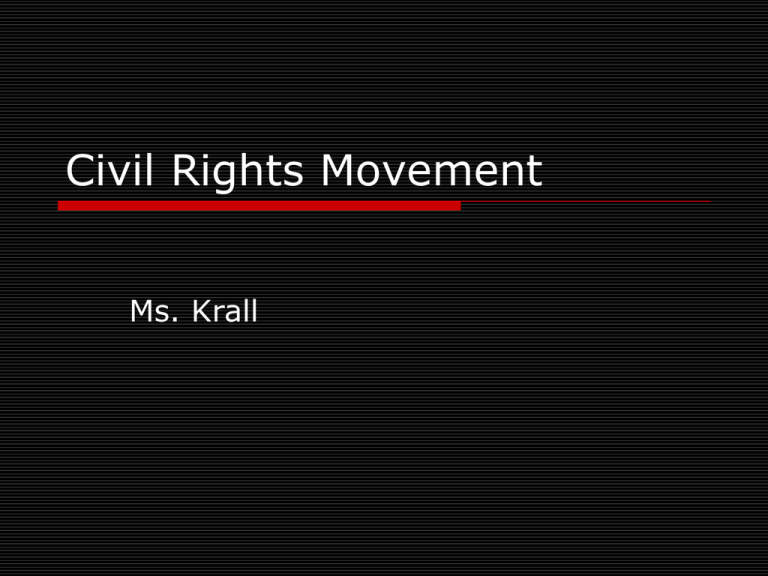
Civil Rights Movement
Ms. Krall
Bell Ringer…
With partner,
read packet and
answer the first 5
questions…
Agenda and
Objective:
Through
discussion and
notes, students
will identify the
early events of
the Civil Rights
Movement.
Pre- Brown
What is
Segregation?
What were the Jim
Crow laws?
What is the
difference between
de facto and de
jure segregation?
Eisenhower years…
Believed that
desegregation
should be a
natural, slow
process and not
forced.
Was forced into the
limelight by Brown
vs. Board of
Education
(Topeka, Kansas)
in 1954.
Welcome Back!
Bell
Ringer…answer
questions in
regards to Brown
v. Board, Emmett
Till and
Montgomery Bus
Boycott.
Agenda and
Objective:
Through
discussion and
notes, students
will identify the
early events of
the Civil Rights
Movement.
What was Brown?
Earl Warren appointed
by Eisenhower as Chief
Justice of Supreme
Court in 1953.
NAACP filed suit on
behalf of Linda Brown,
a black elementary
school student.
Thurgood Marshall
represented Linda
Brown
Topeka school board
had denied Brown
admission to an allwhite school.
Case reached Supreme
Court in 1954
NAACP
began to attack
"separate but equal"
by suing segregated
colleges & universities;
blacks gained entrance
into many Southern
universities.
Elementary and
secondary schools
remained segregated
What was Brown?
Strikes down Plessy v
Ferguson (1896) and
its “separate but
equal” clause.
De Jure segregation
found unconstitutional.
Violates equal
protection clause of
the 14th Amendment.
Reaction to Brown?
1955 Brown II
which
desegregated
schools “with all
deliberate speed.”
Most southerners
opposed Brown
and led to violent
encounters with
desegregation
supporters.
Best
example…1957
Little Rock
Arkansas.
Little Rock Nine
1957 Little Rock
Arkansas Central High
School
Gov. Orval Fabus refused
entrance. National Guard
called in.
Montgomery Bus Boycott, 1955
December 1955, Rosa
Parks arrested in
Montgomery, Alabama,
after refusing to give her
bus seat to a white man;
she was ordered to sit at
the back of the bus.
Found guilty and fined
$14; over 150 others
arrested and charged as
well for boycotting buses
during the following
months.
African Americans called
for a boycott; nearly
80% of bus users were
black.
Rev. Martin Luther King,
Jr. emerged as leader of
civil rights movement
and later became
President of the SCLC.
Montgomery bus
boycott lasted nearly
400 days.
King’s house was
bombed.
88 other black leaders
were arrested and
fined for conspiring to
boycott.
Supreme Court ruled
segregation on
Montgomery buses
was unconstitutional.
On December 20,
1956, segregationists
gave up.
The Murder of Emmitt Till
From Chicago, in
August, 1955 14
year old Emmitt Till
visited his relatives
in Mississippi.
Unaccustomed to
segregation and on
a dare. Emmitt
walked in to a
store, and spoke to
a white woman.
Said “bye baby” to
the wife of the
store’s owner.
Welcome Back!
Bell Ringer…Share Agenda and
the remaining
Objective:
questions with
Through
your neighbor
discussion and
notes, students
Quiz tomorrow!
will identify the
early events of
the Civil Rights
Movement.
The Murder…
A few days later, two
men in the middle of
the night took Emmitt
and killed him.
Three days later,
Emmett Till's body was
found in a River. One
eye was gouged out,
and his crushed-in
head had a bullet in it.
Emmitt’s mother
insisted on an open
casket funeral.
Means of Protest.
Nonviolent passive
resistance
urged followers not to
fight with authorities
even if provoked.
Sit-ins became
effective new strategy
of nonviolence
1960-First sit-in by 4
North Carolina college
freshman at
Woolworth lunch
counter for student
being refused service.
During the Kennedy Years…
Did nothing during
his first two years
because he tried to
avoid losing either
white or black
southern vote.
Civil rights groups
forced his
hand.
SNCC and CORE
Sit-ins and Freedom Rides
May 1961, Freedom
Riders organized by
CORE
Rode interstate buses to
verify that segregation
was not occurring.
In Alabama, Freedom
Riders were arrested by
police, state troopers,
and National Guard;
some were severely
beaten.
More Freedom Riders
kept coming all summer
James Meredith
Kennedy had to
send the U.S. Army
to enforce a court
order to enroll
James Meredith in
the University of
Mississippi.
Gov. Ross Barnett
refused entrance.
Enrolled in
September 1962.
Birmingham, 1963
Birmingham closed
parks, playgrounds,
swimming pools, and
golf courses to avoid
desegregation.
arrested on Good
Friday for marching
without a permit and
spent 2 weeks in jail.
Letter from the Birmingham Jail…
"We know through painful experience that freedom is
never voluntarily given by the oppressor; it must be
demanded by the oppressed. Frankly, I have yet to
engage in a direct-action campaign that was ‘welltimed’ in the view of those who have not suffered
unduly from the disease of segregation. For years now
I have heard the word "Wait!" It rings in the ear of
every Negro with piercing familiarity. This "Wait" has
almost always meant "Never." We must come to see,
with one of our distinguished jurists, that justice too
long delayed is justice denied."
After his release, King
began using black
school children in the
demonstrations
Police commissioner
Eugene "Bull" Connor
used cattle prods and
ordered police dogs on
demonstrators and
used fire hoses on
children as world
watched in horror.
June 1963
Governor George
Wallace blocks two
black students
entering the
University of
Alabama.
“Segregation now,
segregation
tomorrow,
segregation
forever."
Also….
Medgar Evers,
NAACP director in
Mississippi, was
assassinated
The March on Washington…
August 28, 1963
Largest protest in
nation’s history at
that point.
(250,000)
“I have a dream
speech.”
Welcome Back!
Bell Ringer…name
three events that
occurred in 1963
that dealt with
Civil Rights
Agenda and
Objective:
Through notes
and reading
activity, students
will identify
differences
between MLK and
Malcolm X.
Johnson and Civil Rights…
24th Amendment
abolished the poll tax
in federal elections.
Civil Rights Bill of 1964
Desegregate
businesses
Equal Employment
Opportunity
Commission created to
enforce the law.
Title VII:
Discrimination based
on race, religion
gender and national
origin was illegal.
Voting Rights Act
of 1965
Came out of the march
from Selma to
Washington.
Literacy tests unlawful
As a result, 740,000
African Americans
registered to vote in
three years.
Rise of Black Power
Not all African
Americans agreed with
Martin Luther King’s
non-violent methods,
especially northern
blacks.
Black SeparatismCalled for the
separation of the races
in America by
returning to Africa or
occupying an exclusive
area of land in the
U.S. supplied by the
federal gov’t.
Malcolm X
Most vocal and brilliant
orator of Nation of
Islam
Advocated use of
weapons for selfdefense believing
nonviolence
encouraged white
violence.
after his pilgrimage
to Mecca; he left
Nation of Islam
Assassinated on
February 21, 1965,
Racial Violence
SNCC becomes radical
Black Panther party
formed.
Poverty,
unemployment, &
racial discrimination
common in major
inner-cities.
Watts Riots, Los
Angeles, August 1116, 1965
34 people dead, 1,072
injured, 4,000
arrested, 1,000
buildings
destroyed, property
loss nearly $40 million.
1967, 7,000
arrested in Detroit
During first 9
months of 1967,
more than 150
cities reported
incidents of racial
disorders
Welcome Back!
Bell Ringer…What
two pieces of civil
rights legislation
were passed
during Johnson’s
Administration?
Agenda and
Objective:
Through notes
and reading
activity, students
will identify
differences
between MLK and
Malcolm X.
Death of MLK
April 4, 1968 in
Memphis.
"We’ve got some
difficult days ahead.
But it doesn’t matter
with me now. Because
I’ve been to the
mountain top. I may
not get there with you,
but I want you to
know tonight... that
we as a people will get
to the promised land."
Social
Protests of
the 1960s &
1970s
"Black Power"
In the late 1960s, civil rights from
political to economic equality (more
than 50% of northern blacks lived in
poverty)
Leadership shifted from MLK’s nonviolent
protest to militancy
Civil rights began to reflect the overt
embrace of black culture & pride:
rejection of “slave names,” & the “black is
beautiful” motto
1968 Mexico City Olympics
Tommie Smith & John
Carlos
"Black Power"
SNCC leader Stokely Carmichael:
Told blacks to seize power where they
outnumber
whites power comes
“Political
Calledthrough
for black-controlled
unions,
co-ops,
the barrel of
a gun”
& political parties —Huey Newton
The Black Panthers dedicating
themselves to defending blacks from
police brutality & serving their
communities
“Brown Power”
Mexican-Americans began to advocate
for their rights:
“La Raza” called for cultural awareness,
voter registration, education & poverty
reforms
César Chávez organized the Nat’l Farm
Workers' Assoc to demand better pay for
pickers
“Chicanos” called for & won bilingual
education programs
Feminist Movement
Arose during Civil Rights Movement
Betty Friedan: credited with inspiring the start of the
modern women’s liberation movement
1963, The Feminine Mystique, which explores the
idea of women finding fulfillment beyond traditional
roles
Co-founded the National Organization for Women in
1966, and served as its first president
NOW worked for rights of women
1968 In November, NOW member Shirley
Chisholm becomes the first Black woman
elected to the U.S. House of
Representatives. (runs for president in
1972)
Supreme Court and Female
Rights
Griswold v. Connecticut (1965) struck down a state law
that banned the use of contraceptives, even by married
couples, creating a "right to privacy.“
Reed v. Reed and Frontiero v. Richardson, dealt with sex
discrimination in laws and jobs
Roe v. Wade (1973). The court legalized abortion by
ruling that state laws could not restrict it during the first
three months of pregnancy. Based on 4th Amendment
rights of a person to be secure in their persons.
Congress and Female Rights
Civil Rights Act of 1964: Title VII prohibits
discrimination in employment on the basis of race,
color, sex, national origin and religion
Congress passed "Title IX" (1972) which prohibited
sex discrimination in any federally-funded educational
program. This was best seen in the rise of girls' sports
to equal boys'.
The proposed "Equal Rights Amendment" (ERA)
passed Congress in 1972. ERA sought to legislate
equality by stating equal rights can't be denied due to
gender.
The leader against ERA was Phyllis Schlafly. She traveled
the country advocating "STOP ERA" and advocating
traditional roles for women.ERA failed in 1982, 3 states
short of the needed 38.
The Voting
ERA fellon
3 states
State
the shy
ERAof the
¾ needed for ratification
Women began breaking
important barriers
• Sally Ride: first female
astronaut in early 1980s
• Sandra Day O’Connor: first female
Supreme Court justice (appointed by
Reagan in 1981)
• Geraldine Ferraro: first female
vice presidential candidate for a major
party (Democratic party in 1984)
Native Americans
1. Occupy Alcatraz (1969-71)
inspired numerous incidents of
civil disobedience
2. American Indian Movement
founded in 1968
a. 1972, AIM seized the Bureau of
Indian Affairs building in
Washington, D.C. protesting
desperate conditions on
reservations
b. 1973, Wounded Knee, South
Dakota occupied by AIM and
Oglala Sioux
Held it for two months and
gained national publicity
Several died and 300 were
arrested
Leaders eventually acquitted
Gained fishing rights and
millions of dollars for lost
lands
“Rainbow Power”
The Gay Liberation movement started
in 1969 after the Stonewall Riot in New
York City
The Gay Liberation Front demanded end
to discrimination & rallied gays to “come
out”
The American Psychiatry Assoc. ended its
classification of homosexuality as a
disease
½ of all states changed their sodomy &
employment laws
“Yellow Power”
The Asian-American movement began
with the formation of the Asian
American Political Alliance:
Protested U.S. involvement in Vietnam &
use of term “gooks”
Called for & received Asian-American
studies in colleges, health services in
Asian communities, & reparations for
interned Japanese-Americans
Civil Liberties
Civil liberties were protected for people
accused of crimes:
Gideon v Wainwright (1963)—all
citizens, no matter the crime, have the
right to an attorney
Escobedo v Illinois (1964)—citizens
have the right to remain silent during
interrogations
Miranda v Arizona (1966)—suspects
must be told of their right against selfincrimination
Conclusions
The counterculture & “power protests”
used similar methods:
Active & often-militant protest for civil &
economic rights
Cultural pride & awareness
These protests would continue but
would faced confrontation by the
conservative politics of the 1970s &
1980s

